Making Perfect Knife Cuts
For most vegetables (carrots and onions being two of the few exceptions), the most efficient way to dice them also yields perfect results. If you are able to keep the pieces of your veggies organized into neat stacks, you will be able to slice through them several layers at a time, swiftly producing beautiful cuts.
 batonnet: 1/4″ x 1/4″ x 2-2.5″
batonnet: 1/4″ x 1/4″ x 2-2.5″
 julienne: 1/8″ x 1/8″ x 2-2.5″
julienne: 1/8″ x 1/8″ x 2-2.5″
 fine julienne: 1/16″ x 1/16″ x 2-2.5″
fine julienne: 1/16″ x 1/16″ x 2-2.5″
 small dice: 1/4″ cubed
small dice: 1/4″ cubed
 brunoise: 1/8″ cubed
brunoise: 1/8″ cubed
 fine brunoise: 1/16″ cubed
fine brunoise: 1/16″ cubed
For best results, use a sharp knife. Always pay attention as you cut, and work safely.
1) With your cutting hand, use the proper knife grip (pinch the butt of the blade between your thumb and forefinger; grasp the handle with the other three fingers)
2) With your other hand, be careful to hold your fingertips back away from the blade. Your knuckles will help guide the knife and protect you from accidentally cutting your fingers.
3) Slice one edge off and put it to the side. Put the flat portion of the potato on the cutting board. Having a flat bottom will help keep the potato from rolling as you slice.
 Doing so leaves you with a flat side to what would otherwise be a round object.
Doing so leaves you with a flat side to what would otherwise be a round object.

Put the flat side down onto the cutting board so that your veggie doesn’t roll out from under your knife while you’re working. It’s impossible to accurately cut something when you don’t know where it’s going to be while you’re slicing through it. Attempting to do so is a good way to take a chunk out of your fingers.

4) Slice the potato into equal intervals of 1/4 inch. You may find that carefully holding the piece you have just sliced with your index finger will help keep the pieces in order, thereby making it easier for you work neatly. Doing so will also allow you to work more efficiently and have an easier time keeping the potato slices in a stack in step 6.
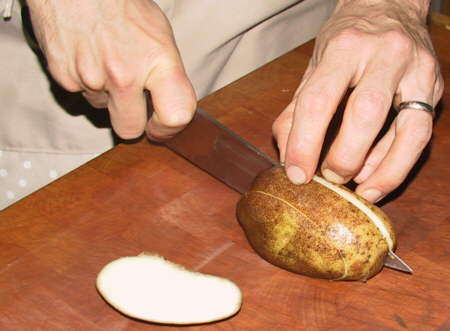
Be careful as you reach the end of the veggie—if your flat side does not extend all the way to the edge of what you’re cutting, the end of it will have a tendency to roll unless you’re careful.

If you’re not able to safely cut the last piece with it in place as shown above, remove it from the rest of the stack and rotate it 180 degrees so that your guide hand rests on the edge that has already been cut. By doing so, you will rest your weight more squarely over what’s left of the flat edge on the cutting board while simultaneously giving yourself a more regular surface to grip with your guide hand. The combination of the two advantages should assist you in making the last cut.
6) Divide the potato into 2-3 stacks of the slabs you have just cut. Position each stack so that the widest piece is the base. If you have a hard time getting the pieces to stack up well, divide them into smaller stacks—you want to be certain that nothing shifts on you while you’re in the process of slicing!
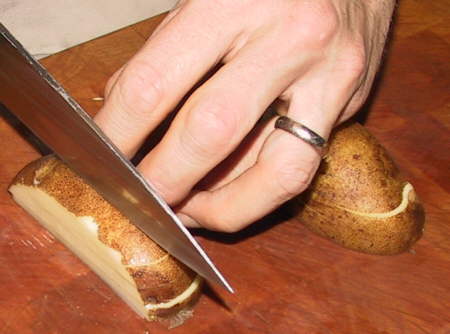
7) Slice each of these stacks into sticks at the same 1/4-inch interval as before—-your aim will be to get each piece of potato to the same exact size! Again, working neatly will allow you to work efficiently.
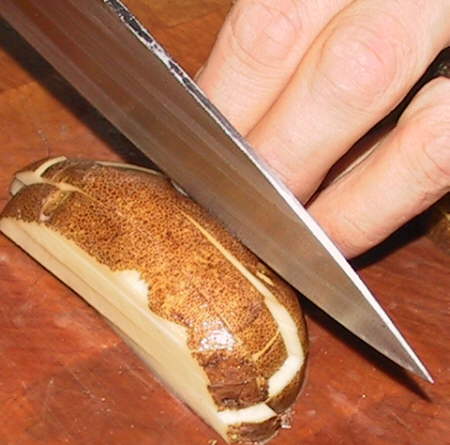
The best place for your thumb as you approach the end of the line is at the rear of what’s left to be cut, holding it in place so it doesn’t slide out of the way.
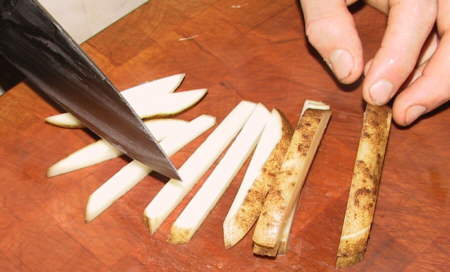
When you have finished this series of cuts, you should be left with regularly-sized sticks. Depending on what interval you have chosen to cut at, these should be batonnets, juliennes, or fine juliennes (battonet pictured).
To continue slicing them down to a dice, don’t remove them from their natural stacking order. It’s always easier to work with a vegetable if it is fit together like a puzzle because the pieces match and are stable. Cut crosswise across the stacked pieces at the same interval you’ve been cutting to finish the pieces into nearly perfect cubes.
With practice, you’ll find that your ability to cut equally-sized potatoes will improve quickly.
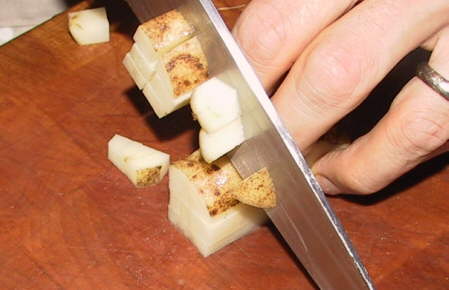
Store any potatoes you’re not using immediately in cold water to prevent them from turning brown. Store them in the refrigerator for up to three days and drain before using.
If you’d like to see the process in action, watch this 14-second video of me cutting a potato.
Photo credits: Aurora Sharrard
September 20th, 2006 at 3:31 pm
[...] Zucchini is a great vegetable on which to practice cutting brunoise and fine brunoise—you know, the little, tiny dice cuts. But then what to do with all that zucchini? Personally, I make muffins. They’re quick, they’re easy, and they’re tasty. You can’t ask for much more. [...]
October 2nd, 2006 at 10:43 am
[...] This dish is a great way to practice your knife skills, too—it will give you a chance to practice dicing potatoes, carrots, and onions; peeling garlic; and introduce you to a great way to slice leaves of anything: the chiffonade cut! [...]
October 7th, 2006 at 5:26 pm
[...] spinach, swiss chard, arugula Assume a couple minutes of sauteeing (or, if applicable, roasting) time between each level if your vegetables are cut to a small dice; longer the bigger they are. I’m sure I’ve forgotten a few vegetables from the list. If I’ve neglected your favorite veg, post a comment and I’ll fit it into the list for you. [...]
October 10th, 2006 at 5:04 pm
[...] Give me a choice between a sharp knife and a food processor, though, and I’ll choose the knife almost every time. Not that the food processor doesn’t have its place occasionally: I’d never be able to make bread crumbs from leftover heels of stale, frozen bread without mine. Likewise it’s handy if I want to grate a large amount of cheese or perhaps even to make pesto (though quite honestly, I think the blender a better tool for that task). As far as mincing vegetables goes, though, I’d just as soon cut mine to a very fine brunoise; and unless I’m making a very huge coleslaw, I’ll shred my cabbage manually, too. [...]
November 3rd, 2006 at 9:02 am
[...] Then, slice and dice your pepper according to standard procedure. Photo credits: Aurora Sharrard [...]
December 5th, 2006 at 6:25 pm
[...] Basic Technique 1: Learn the names of the different sizes of cuts and how to make them, then practice by cutting potatoes: lots and lots of potatoes. [...]
December 22nd, 2006 at 11:45 am
[...] One method I often use when making a tomato sauce involves making a pincage–caramelizing tomato paste in the pan at the beginning of the process before adding the liquid. To make a pincage, start with some fat in the pan. Crosswise-cut strips of bacon (often called lardons or lardoons) make a great start if you like that sort of thing; otherwise oil or butter will work just as well. Cook brunoise-cut root vegetables in the fat until they atart to get tender, then add the tomato paste. Stir it constantly with a wooden spoon. it will start to develop a fond on the bottom of the pan. This is OK as long as it’s an attractive brown color, but when it starts to get too dark, pour in an ounce or two of water to help deglaze it. Continue the process until your pincage is a rich caramel color, or until you run out of time and/or get sick of stirring it, whichever comes first (though you should try to spend at least five to eight minutes on it at minimum). Once you’re done caramelizing your pincage, do a final deglazing with a couple ounces of red wine. Let it reduce by at least half, then add the rest of your liquid ingredients (ie tomatoes, either canned or fresh). The tomato paste will help to thicken your sauce; caramelizing it first will help to develop its sweet flavor. I never put sugar in my tomato sauce and don’t understand why Escoffier would recommend that someone should. Too bad I can’t argue the point with him. Source: The Escoffier Cook Book: A Guide to the Fine Art of Cookery. Escoffier, Auguste. New York: Crown Publishers, 1959 (20th printing). [...]
January 26th, 2007 at 1:32 pm
[...] My next savory waffle dinner was for a wider audience: Tomato Waffles with Cauliflower Curry Sauce as dinner for five. I added the tomato flavor to the waffles by caramelizing tomato paste in a skillet with fine-brunoise-cut onions and carrots (a preparation known as a pincage) and added it to the milk in the waffle recipe. To make a pincage, you must stir the tomato paste constantly, occasionally deglazing the pan with a bit of water to keep any of the tomato paste from scorching on the bottom of the pan. It’s a time-consuming process, but it’s worth it because it develops the tomato paste’s flavor and makes it taste less like the processed tomato product that it is. In the end, though, it wasn’t quite enough tomato; my tasters recommended adding sun-dried tomatoes to the batter next time I make them. The curried-cauliflower sauce relied on reduced beer and water for its liquid component and wasn’t quite clingy enough, though it had good flavor. Tasters recommended that I add some yogurt to it next time for richness and texture. I’m looking forward to implementing these suggestions sometime soon. [...]
March 30th, 2007 at 1:44 pm
[...] I rarely use the press myself (only when I definitely want a smashed clove, like for a Caesar dressing [which, on a side note, is very tasty and microbially safer if you use hard-boiled egg yolks instead of raw yolks, and then you can crumble the egg whites over your salad {yum!}]), preferring finely minced garlic for most purposes. Admittedly, it takes more time, but it’s a good chance to practice knife skills as you aim for a fine brunoise. [...]
June 2nd, 2010 at 12:45 am
Just thought you might want to check out my new website where I offer my handmade cutting boards and butcher blocks.
Thanks for your consideration!
Lou Wein